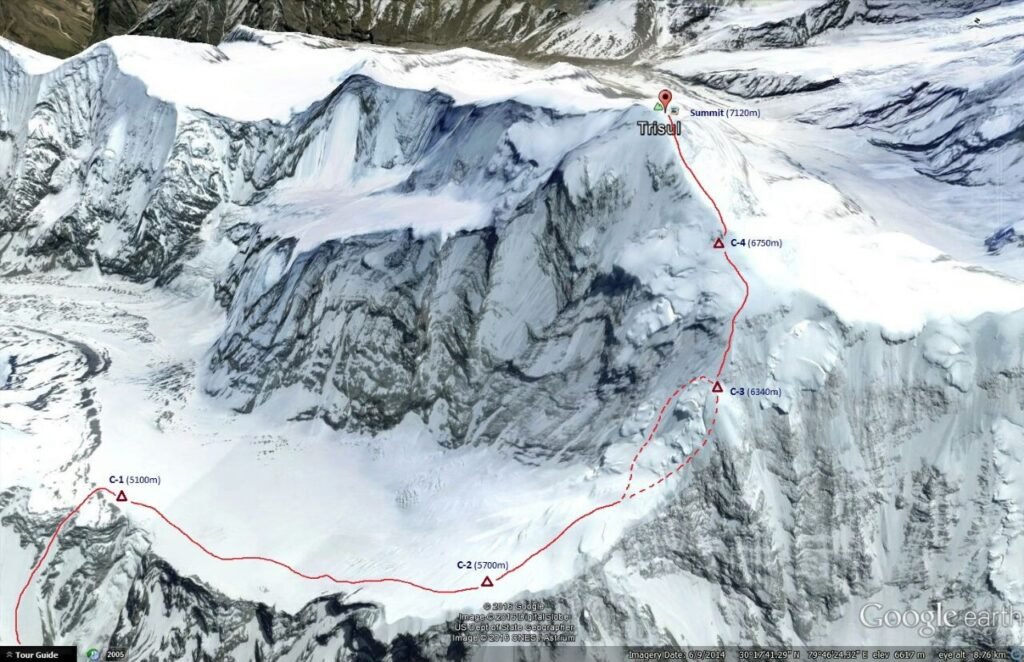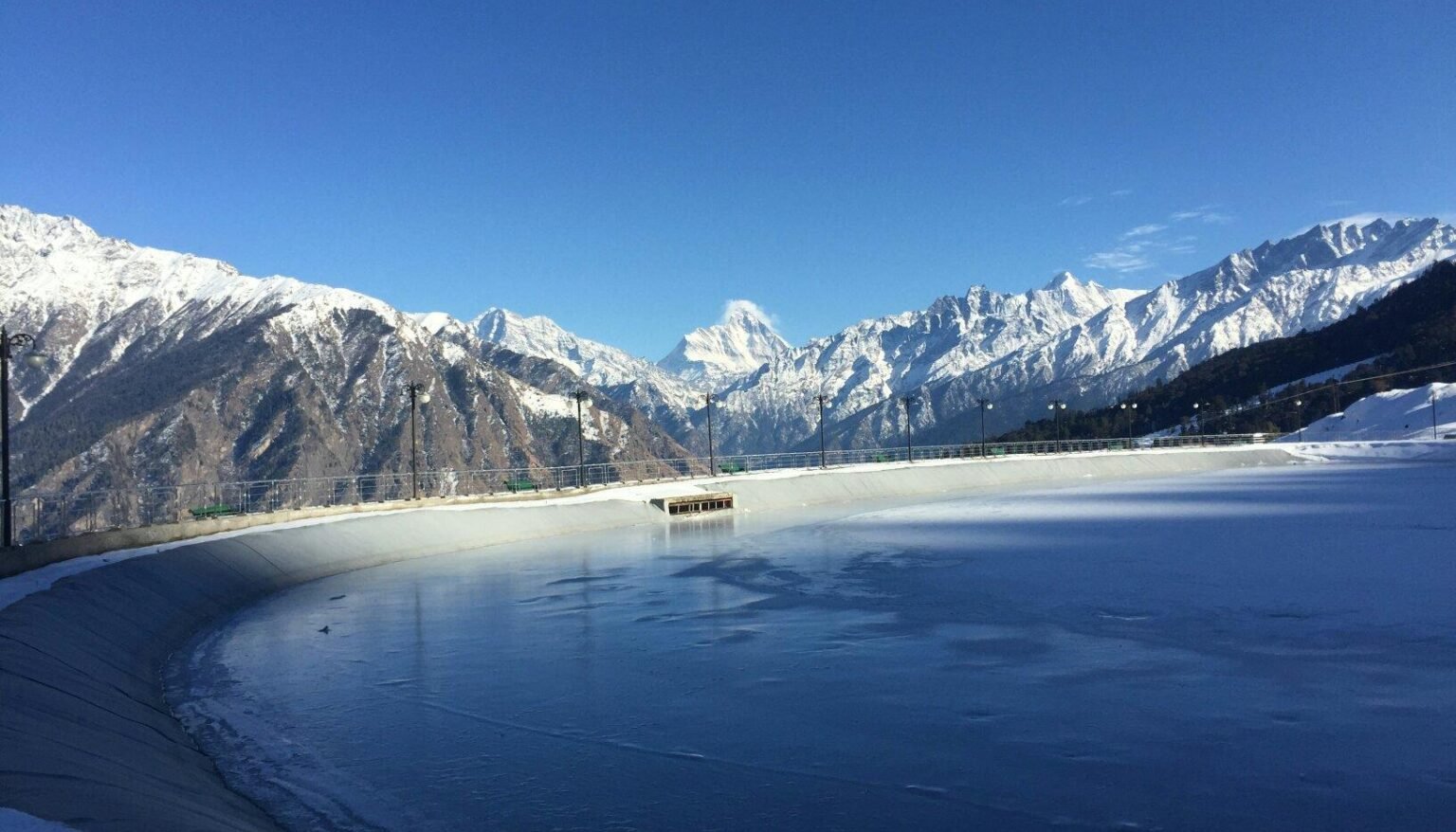Trisul Mountain, a captivating gem of the Kumaon Himalayas in Uttarakhand, India, is famed for its striking trident shape and rich spiritual symbolism. Forming a breathtaking backdrop to the Nanda Devi Sanctuary, Trisul Mountain’s distinctive trio of peaks, Trisul I, II, and III, enthral mountaineers, trekkers, and cultural seekers alike. From pioneering climbs in the early 20th century to its vital place in Hindu culture as Lord Shiva’s trident, Trisul Mountain remains a beacon of adventure and devotion.
Geography and Location
Trisul Mountain stands majestically in the western Kumaun region of Uttarakhand, India, within the Nanda Devi Biosphere Reserve, a UNESCO World Heritage Site celebrated for its biodiversity. The massif’s coordinates are approximately 30.31278°N, 79.77722°E. Trisul comprises three distinct peaks:
| Peak | Height (m) | Height (ft) |
|---|---|---|
| Trisul I | 7,120 | 23,359 |
| Trisul II | 6,690 | 21,949 |
| Trisul III | 6,007 | 19,708 |
Trisul forms the southwest corner of the ring of peaks enclosing the sacred Nanda Devi Sanctuary, with neighbouring summits like Nanda Ghunti.
Characteristic Features
Beyond its trident shape, Trisul Mountain boasts rugged ridges and steep slopes that challenge even seasoned climbers. Its snow-capped summits glisten from afar, creating panoramic vistas that can be best admired from Kausani and along the famed Roopkund Trek. The massif runs north-to-south, with Trisul I anchoring the northern edge and Trisul III at the southern tip.
Key Details:
| Trekking Route Points | Key Locations |
|---|---|
| Start & End Points | Rishikesh, Almora, Kathgodam, Debal, Wan, Bedini Bugyal, Roopkund |
| Camps on Trek | Base Camp (Sutol), Advanced Base Camp, Camp 1, Camp 2, Summit |
| Landmarks | Bedini Bugyal (meadow), Roopkund Lake, Nanda Devi Sanctuary, Auli |
| Viewpoints | Kausani, Ranikhet, Chamoli, Nandakini Valley |
History and Mythology
Trisul Mountain’s history is etched not only in the annals of mountaineering but also in the sacred lore of India. In 1907, British explorer T.G. Longstaff led the first ascent of Trisul I, making it the first 7,000-meter peak summited anywhere in the world. This achievement marked the dawn of high-altitude mountaineering in the Greater Himalayas and brought global recognition to the region.
The name “Trisul” derives from the Sanskrit trident, Trishula, belonging to Lord Shiva, the powerful Hindu deity of destruction and transformation. Local legend venerates the mountain as Shiva’s throne; villagers and pilgrims regularly honour the peaks through prayers and rituals, reinforcing the mystical allure and reverence that surrounds Trisul.
Cultural and Spiritual Influence
Trisul isn’t just a geographical marvel; it’s a symbol deeply woven into the spiritual fabric of the Kumaon region. The local inhabitants revere the peaks as divine, considering them the physical embodiment of Shiva’s cosmic weapon. During auspicious times, trekkers and pilgrims trek to vantage points not only for adventure but also for spiritual connection and meditation.
Festivals, prayers, and rituals associated with Trisul highlight the mountain’s significance in Hindu culture, drawing visitors seeking both thrill and transcendence.
Climatic Influence
The climate around Trisul Mountain is typically alpine, with severe cold and heavy snowfall from November through April. The trekking season is best from May to June and September to October, when the weather clears and the trails become accessible. Sudden avalanches and unpredictable weather occasionally pose risks, emphasising the need for safety and preparation.
Tourist Spots and Viewpoints
Trisul Mountain is a magnet for trekkers and adventurers. Popular points include:
- Bedini Bugyal: A lush alpine meadow offering spectacular views of Trisul and the surrounding ranges.
- Roopkund Lake Trek: This legendary trail leads trekkers close to Trisul, passing through mystical forests and ancient villages.
- Auli and Kausani: These hill stations provide sweeping vistas and a tranquil base for exploration.
Platforms such as these are ideal for photography, meditation, and soaking in the grandeur of the Himalayas.
Trekking and Route Details
Trisul offers challenging expeditions, with several established routes. The classic access follows:
- Almora – Kausani – Garur – Gwaldam – Debal – Bagargad – Wan – Bedini Bugyal – Kelva Vinayak – Roopkund – Trisul.
- Base Camp to Advanced Base Camp (ABC): The trek begins at base camp and moves towards ABC, traversing forests, rivers, and meadows.
- Advanced Base Camp to Camp 1 (C1): Climbers steadily gain altitude, acclimatising to the thin air.
- Camp 2 to Summit Push: The final ascent typically starts at dawn to maximise favourable conditions and minimise avalanche risk.
The trek from Dhakuri to Khati spans around 10 kilometres, passing through forests of oak and rhododendron. From Khati, trekkers journey onward to Dwali and Bagargad, moving deeper into the sanctuary.

Mountaineering History and Expeditions
- First Ascent: Led by T.G. Longstaff in 1907, Trisul I holds iconic status as the first 7000m peak ever climbed in the Himalayas.
- Record Expeditions: Routes on the north ridge, west face, and south ridge have all seen notable climbs, with technical ascents attracting mountaineers from around the world.
- Trisul II & III: These were first climbed by a Yugoslavian team in 1960, adding international prestige to the massif.
- Modern Challenges: Expeditions now face both natural hazards, like avalanches, and the logistical demands of modern high-altitude climbing.
Safety, Access, and Accommodation
Transportation options are plentiful:
- Road: Kausani and nearby towns are well-connected by bus and taxi to major cities like Kathgodam.
- Rail: The nearest station is Ramnagar, providing easy access for travellers.
- Air: Pantnagar Airport, about 291 kilometres away, serves as the closest air link.
Accommodation ranges from cosy lodges in Kausani and Auli to tented base camps along the trekking route.
Trekking Tips for Enthusiasts
- Acclimatise properly to avoid altitude sickness and maximise summit success.
- Hire experienced guides to ensure safety and route-finding.
- Carry weather-appropriate gear, especially during shoulder seasons.
- Coordinate logistics in advance for transport, food, and emergency support.
Conservation and Responsible Travel
Trisul Mountain sits within the Nanda Devi Biosphere Reserve, home to rare flora and fauna. Trekkers are encouraged to follow eco-conscious practices, avoiding litter and preserving the habitat for future generations. Participating in local cultural rituals and supporting village economies enhances both the trekker’s experience and community sustainability.
Recent News
Trisul continues to make headlines for both triumph and tragedy. A notable recent event involved an Indian Navy expedition struck by an avalanche, resulting in fatalities and rescue operations that drew national attention. These incidents underscore the mountain’s power, beauty, and the respect it commands among climbers and locals.
In a dramatic rescue operation, an Indian Navy mountaineering team faced a devastating avalanche while attempting the summit of Trisul Mountain, Uttarakhand. The incident, which resulted in fatalities and missing climbers, drew national focus to both the allure and peril of Himalayan expeditions. Authorities and experts now call for increased safety protocols and technological aid for future high-altitude missions, reinforcing Trisul’s reputation as a site of both victory and sober respect in the annals of Indian mountaineering.
FAQs About Trisul Mountain
Where is Trisul Mountain located?
Trisul Mountain rises in the western Kumaun region of Uttarakhand, India, embracing the Nanda Devi Sanctuary.
What is the height of Trisul I?
Trisul I stands at a majestic 7,120 meters (23,359 feet).
Why is Trisul Mountain considered sacred?
Its trident shape symbolises Lord Shiva’s Trishula, making it a living shrine in local Hindu beliefs.
What is the best time for trekking Trisul?
May, June, September, and October present the most favourable weather for trekking and summit attempts.
How difficult is the trek or climb?
Trisul is regarded as a technical and demanding peak, suited for experienced climbers.
Which routes access Trisul Mountain?
The conventional trekking route includes Almora–Kausani–Garur–Gwaldam–Debal–Bagargad–Wan–Bedini Bugyal–Kelva Vinayak–Roopkund–Trisul.
Are there safety concerns with Trisul?
Avalanches and unpredictable weather are regular challenges; climbers should be well-prepared and heed local advisories.
What are the must-capture locations for photography?
Bedini Bugyal, Roopkund Lake, and Kausani offer panoramic views, especially at sunrise and sunset.
What cultural events relate to Trisul Mountain?
Local rituals, festivals, and mountaineering accolades celebrate Trisul’s spiritual and historical impact each year.
